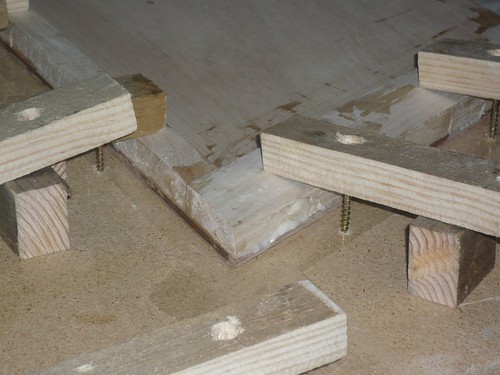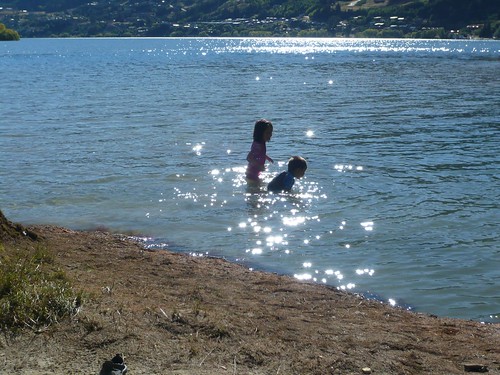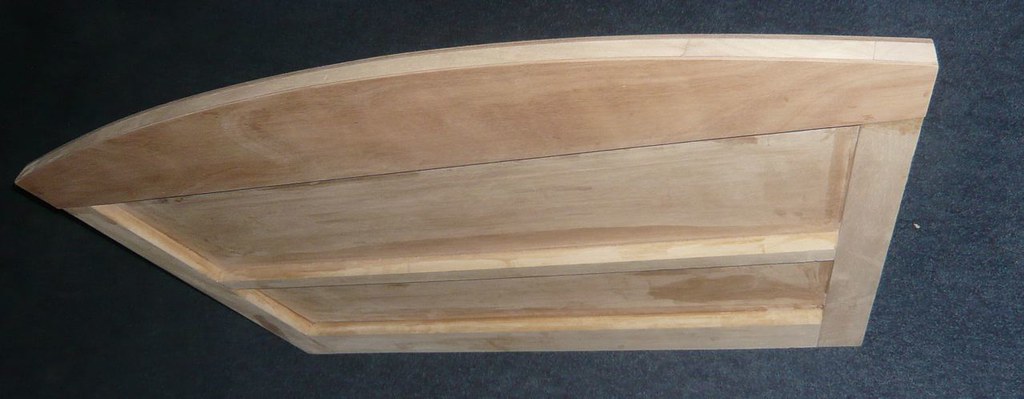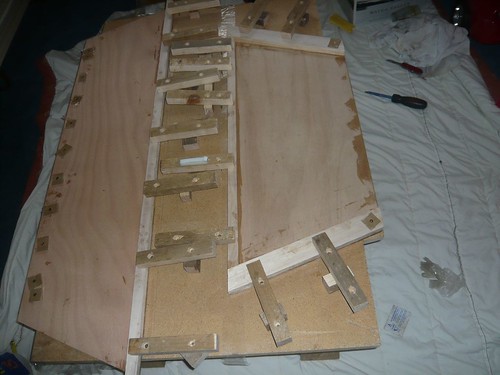 Thanks: 0
Thanks: 0
 Needs Pictures: 0
Needs Pictures: 0
 Picture(s) thanks: 0
Picture(s) thanks: 0
Results 16 to 30 of 182
-
7th April 2010, 09:43 AM #16
 Senior Member
Senior Member











- Join Date
- Mar 2010
- Location
- Queenstown New Zealand
- Posts
- 382
 Carbon Mast and Yard
Carbon Mast and Yard
C-Tech in Auckland do have the mandrells to make what seem like suitable sections:
Mast: 76mm ID tapering to 45mm at the tip
Yard: 38mm ID tapering to 20mm at the tip
If I'm doing the maths correctly, the 76mm ID mast section at 1.5mm wall or so would be absolutely bombproof - 25% stiffer than the 82/58mm square oregon section but weighing perhaps 2.5kg.
1.2mm section almost exactly the same stiffness as the box section oregon but more chance of a ding causing you problems.
Yard and mast of carbon would cut perhaps 9kg in total from the weight in the air.
Will post when I have prices. (Please don't tell my wife...)
Ian
-
7th April 2010 09:43 AM # ADSGoogle Adsense Advertisement
- Join Date
- Always
- Location
- Advertising world
- Posts
- Many
-
9th June 2010, 10:41 AM #17
 Senior Member
Senior Member











- Join Date
- Mar 2010
- Location
- Queenstown New Zealand
- Posts
- 382
 Boat Building with Kids
Boat Building with Kids
I'm cruising along quietly making all the small parts - bulkheads, transom, foils, etc. Not spectacular progress, but when I first though about the project, I figured I couldn't start before the spring (when one kid will start school, and the other kindergarten, and I'll have some midweek time free) but then I thought, any progress before then is good progress, get the plans and some ply and start on the small bits. With luck, I'll have all the bulkheads, foils, centreboard and rudder case ready by the spring, may even have the sides and bottom cut out and joined with buttstraps and chinelogs on the sides if I can figure out keeping that length warm while the epoxy goes off overnight. (Its zero to five degrees celsius in the garage at the moment) As soon as it gets warmer in the spring, epoxy precoat the bigger bits, go 3D and get the rest of the way as quickly as possible.
Things I've found out so far:
I don't need any power tools (yet).
The Japanese pull saw cuts the ply almost as quickly as the jigsaw, but more accurately so no/less planing down to the line needed.
I don't need any clamps:
I'm gluing up bulkheads on a piece of chipboard with screws and short pieces of scrap wood holding things down, I'll try the same concept with two pieces of scrap and a screw/spacer inbetween for all my other clamping needs. Can make up a dozen or two clamps in an hour, so should have plenty by the time I come to the gunwales.
I can mix the epoxy glue directly in the ziplock bag using syringes from the pharmacy (about a dollar each). 4:1 Epoxy so multiples of 20ml from one syringe 5ml from the other for the small jobs, multiples of 60ml and 15ml for bigger jobs. Squirt directly in the ziplock, massage to mix, add glue powder with more massaging and it's ready to go.
Someone commented a while back that Lake Wakatipu is too cold for capsizing or swimming - I agree, but please don't tell my kids!
Ian
-
9th June 2010, 08:10 PM #18

I totally agree about the Japanese pull saws. One of the most useful tools for boat building you can have in the tool chest. Before building my GIS I thought a needed a table saw. A table saw soon went way down on my list of tools. However, I admit I was lucky enough to have most of my timber nicely dimensioned for me.
That's a great clamping solution Ian. Probably better than gravity clamps like house brick and old car batteries because you can control the pressure and see what's going on a bit better, ie. correct squeeze out and easier to clean up too.
What kind of timber is that framing? If I had to guess I'd say it looks a bit like Paulownia.
-
12th June 2010, 09:26 AM #19
 Senior Member
Senior Member











- Join Date
- Mar 2010
- Location
- Queenstown New Zealand
- Posts
- 382

Yes, found this clamping system works well, though note the strategic placement of clear packing tape - you'd look pretty silly if you glued the transom down to that big sheet of chipboard! Easy to clamp things up with only two hands, and things don't slide around on the greasy epoxy the way they do with conventional screw clamps or weight. Keeps the building portable - I can start a glue up in the sun in the garden in the middle of the day, get two pieces of framing timber attached to the ply, do some cleanup, go off and pick up a kid from kindy, come back, mix some more glue, clamp the other bits on, then put the whole board in the spare bedroom to cure overnight. Garage is 0 to 5 deg celsius at the moment sometimes -4 at night so it'll be hard to work in there for another 3 months or so.
Yes, framing timber is paulownia - Rod - Paulownia Enterprises (NZ) - High Quality, Lightweight Paulownia Timber For Sale - did a good job of cutting up the timber. I simplified the cutting plan down to only 20x50mm and 20x25mm sizes - think I can get everything, including foil batterns and centreboard spacers out of that.
Ian
-
12th June 2010, 10:12 AM #20
 Senior Member
Senior Member











- Join Date
- Mar 2010
- Location
- Queenstown New Zealand
- Posts
- 382
 Is it possible to go lighter?
Is it possible to go lighter?
Good to see woodeneye's build come in at under 50kg with Paulownia framing.
https://www.woodworkforums.com/f169/b...ml#post1165139
Comments from Woodeneye:
I've been thinking along similar lines - how far can I push the use of Paulownia to keep weight down? I'm adding a little weight with widening and boxing in the middle seat, much as Watermaat has done (where is he, did he disappear over the horizon on that big boat he bought when his GIS was nearly complete?), but I want to keep weight down as I'll likely be roofracking to the water (only 5 minutes away) for a while once the boat is complete.
Things I've done/am doing/considering doing beyond using Paulownia for framing and chinelogs:
Transom stiffener from Paulownia with 4mm gaboon ply on top - already done - maybe 400g lighter than a transom stiffner of 450 - 500kg/m^3 timber.
Bulkheads 3 and 4 and ones sealing off front of middle seat from 4mm gaboon ply - have already done bulkheads 3 and 4 this way.
Middle and rear seat tops from 4mm ply with a bit more light framing underneath - not sure on this one, need to figure if it's worth it. Leave front seat top 6mm as it's helping hold up the mast support structure.
Gunwales of Paulownia, but still with a thin hardwood (vic ash?) cap on the outside. Was thinking of capping the gunwale top with a thin strip of vic ash also so that no paulownia is showing on the top and sides of the gunwale, but could maybe keep it simpler if the Paulownia surface hardens up nicely with epoxy coating.
Inwale spacers of Paulownia.
Inwales of Paulownia? Was thinking again of a thin hardwood cap for wear/dent resistance but maybe leave it off?
Mast step of two 20mm layers of Paulownia but with a layer of 6mm ply on top to maintain cross grain strength.
Mast partner of 20mm thick Paulownia but with 6mm ply on the bottom surface for cross grain strength. Possibly a sandwich of (from the bottom) 6mm ply, 20mm paulownia then the 6mm ply of the seat top.
Looking forward to some feedback!
Ian
-
12th June 2010, 12:16 PM #21

Hi Ian
I think sandwiching and making composites incorporating Paulownia is a good way to go to make a light and strong structure. It is being used this way for really big boats too.
Personally I think Paulownia for the inwales and gunwales would be fine, but as this is a major structural element I would find out what Mick's thoughts are.
The Paulownia transom stiffener capped with 4mm ply is a winner I think.
The seats are structural elements that stiffen the hull, so I would not use 4mm ply there, except for where you box in the mid seat.
I'm not sure about the mast step and partner either, but Paulownia sandwiched with 6mm ply will possibly be OK. There are big forces carried by these elements. Again, it's best discussed with the designer first.
-
13th June 2010, 08:54 AM #22
 Senior Member
Senior Member











- Join Date
- Mar 2010
- Location
- Queenstown New Zealand
- Posts
- 382
 Paulownia Sandwiches
Paulownia Sandwiches
Yes, will check with Mik before proceeding. I'm more motivated by using the wood I have (lots of 4mm, 6mm gaboon ply and 20mm Paulownia) in the mast partner area than by weight saving - it seems like it must be possible to make something just as strong out of a layer or two of ply with Paulownia in the middle, but I'll wait to see what Mik says.
There seems to be a complete lack of quality medium density softwood down this way (but I can get Vic Ash/Tassie Oak easily enough) - our softwood is all fast growth radiata pine or doug fir with very wide growth rings, so I'm trying to do everything as Paulownia, or a sandwich of ply/paulownia/vic ash with Paulownia in the middle where it needs to be stronger.
Ian
-
14th June 2010, 05:14 PM #23

Howdy,
For sailing loads the paulownia would be fine. However from experience I know that cedar gunwales and inwales do tend to dent. With racing craft you can get away with it, but a utility boat like the Goat is going to get more serious bumping around at some point.
So that's why I specified a timber more dense than cedar for places where it might get thumped.
Paulownia is softer still so would be quite vulnerable. Of course you could do tricky things like laminate some more dense timber along the area that might get thumped or bumped. Like the outer gunwale lamination.
Best wishes
Michael
-
27th June 2010, 10:33 AM #24
 Senior Member
Senior Member











- Join Date
- Mar 2010
- Location
- Queenstown New Zealand
- Posts
- 382
 Progress Report
Progress Report
Yes, I'll be capping any Paulownia I use on the gunwales with Vic Ash so the edges can take a knock. Would probably go with hoop pine if I could get it, but timbers I have/can get easily are Paulownia and Vic Ash (can get radiata pine and very knotty doug fir but don't want to use it).
Have all the bulkheads and transom completed, am just getting on to gluing up my foil blanks. Transom stiffner is Paulownia with 4mm Gaboon on the top, may cap the exposed paulownia on top with a thin strip of Vic Ash.

Have found the surform rasp most useful for doing the bevels on the bottom and sides of the bulkheads and transom. Opens up the possibility of being able to fit a complete boat building tool kit in a couple of pockets:
Japanese Pull Saw
Screwdriver and assorted screws
Surform Rasp
Sanding Block, sandpaper and packing tape
Syringes, ziplock bags for mixing epoxy, old credit card for cleaning up
Actually, I've used a portable power drill to make up my wooden clamping system, but I think that's about it.
Ian
-
27th June 2010, 01:32 PM #25

I would add a random orbit sander because it saves so much time. Same too for a jigsaw.
But I am an impatient builder and always want to go sailing!
MIK
-
8th September 2010, 08:19 AM #26
 Senior Member
Senior Member











- Join Date
- Mar 2010
- Location
- Queenstown New Zealand
- Posts
- 382

Weather is getting warmer, guests are out of the spare bedroom, carbon mast and yard are coming shortly, so it's time to get back to boat building.
A question for Mik:
Is it possible/sensible (or otherwise) to glue the gunwales on to the ply sides at the same time I glue the chinelogs on? (i.e. before I go 3D)
My gunwales will be of Paulownia, later they'll get a thin cap of Vic Ash on the outside and the top.
Plans say clamp the gunwales on at the time you're going 3D, I wonder why not have them glued on at that point?
Thanks, Ian
-
9th September 2010, 11:13 PM #27

Sorry about not answering this.
I have a great deal of confidence in the paulownia structurally. The main thing with plywood boat design is getting the bonding areas right so the loads are transferred into the plywood. The plywood pieces are so strong in the way they are loaded and have so much cumulative bonding area that it is almost hard to imagine enough local load building up for something to break.
The problem with Paulownia is that it can dent easily - so that's the limiting factor rather than anything else. But if not too exposed it will be fine as far as anything else you can throw at it.
There is always some chance you can break a boat - you just have to hit it hard enough - it will break no matter how strong it is if you hit it hard enough. But we have seen from all the Goats in the water that the structure itself is quite dependable. People can just use the boat and if carefully put together it is a very reliable structure.
So the advice is that you can use paulownia almost anywhere except gunwales and inwales and the bottom skids. Maybe the knees and transom top frame are a bit vulnerable.
I don't know how clear your Radiata is in NZ. I know that beautiful slow grown radiata was used for some of the Mullet boats in the early days and was very well regarded.

A NZ Mullet boat - they WERE fishing boats.
The problem with Radiata in OZ is that it has heaps of knots and is so fast grown the grain structure is very coarse and the timber is unstable - it twists up while you look at it.
This is not a problem of radiata, but rather a problem with many plantation grown timbers.
So if the radiata has a reasonably fine grain and is clear I would be happy to see it used where you need a bit more toughness. Probably would definitely use something about that density for the mast step and partner too - just to take the actual thrust from the mast. Otherwise the paulownia might dent back and the mast be supported mostly by the hard plywood edge.
Best wishes
Michael
-
9th September 2010, 11:27 PM #28

Hmm ... didn't handle these questions very well did I!
Don't puth the gunwales on at the same time - it will make the sides of the boat a real cow to bend. They are hard enough with just the chine log.
Also there is a problem with unpredictable hollowing out of the ply panels when they are constrained by stiffer pieces on top and bottom edges. I had that problem when I first built BETH with chine log and sheer clamp in place. I bent them into shape around the bulkheads to find that if you put a straight edge vertically on the side of the hull the middle part of the side panel was a good 12mm away from being straight. It bows towards the side the stiffeners are on.
I think the gunwales will be OK with your construction ... I would probably use something other than Paulownina for the inwales though. Because of their angle they tend to get a bit of a hammering for various reasons.
Dry trial assembly is a very sensible choice.
With the gunwales .... you assemble without them but then clamp them on before the bulkhead, stem and transom gluing goes off. This is so they temporarily hold the sheerline in a fair curve and make sure there are no local distortions around the frame areas.
Best wishes
MIK
-
10th September 2010, 12:08 AM #29

I would agree with MIK that adding the gunwales prior to assembly would cause huge problems, even if you could assemble the 16 gorillas needed for the job.
My thoughts are that the Paulownia could work for the gunwales/inwales if you capped them with a hardwood. You could also cap them with a hard pine such as hoop or kauri, but of course this is an extra building step for the inwales. However, the inwales take a bit less abuse than the gunwales, so you could just use the old cricket bat trick to harden the paulownia. A good rolling with a steel rolling pin prior to sealing with 3 coats of epoxy would help to minimise denting, but it will still happen (cricket bats still dent too!). If you are prepared to live with a slightly knocked around look, then Paulownia should be OK on its own for the inwales.
That said, there is different reason that I would prefer to follow MIK's advice for not using Paulownia for the inwales and gunwales. I have embarrassingly tipped my GIS over on the shore and in the shallows 4 times now. On two of these occasions I've emptied the water by tipping it on its side. I would not want to risk tipping a Goat with Paulownia gunwales/inwales on its side if it was filled with water.
-
10th September 2010, 05:01 PM #30

Howdy,
A couple of minor disagreements.
The GIS gunwale structure is quite huge relative to other boats of this size - once you take gunwales and inwales into account. Additionally the hardwood strip on the outside means that it won't rupture until you load up the hardwood - and it is maybe twice the strength of spruce or fir - which would normally be adequate.
I don't have much fear about those gunwales.
Over a longer time the inwales can get a bit of beating around - only because they protrude above the sheerline. So they tend to cop it from tie down straps (or boat cover if you use one) and things being put clumsily into the boat.
It wouldn't be a structural problem, just that the wood might get dented - say from the trailing edge of the centreboard hitting it.
MIK
Similar Threads
-
Trip to New Zealand
By Allan at Wallan in forum WOODIES JOKESReplies: 0Last Post: 2nd May 2008, 06:13 PM -
New Zealand Holiday
By dazzler in forum NOTHING AT ALL TO DO WITH WOODWORKReplies: 27Last Post: 15th October 2007, 01:14 PM -
Thank You New Zealand
By ozwinner in forum NOTHING AT ALL TO DO WITH WOODWORKReplies: 6Last Post: 18th December 2006, 01:26 PM -
New Zealand Florin
By lesmeyer in forum NOTHING AT ALL TO DO WITH WOODWORKReplies: 1Last Post: 9th November 2006, 02:26 AM -
How to speak New Zealand
By Phil Spencer in forum WOODIES JOKESReplies: 26Last Post: 20th July 2005, 10:17 PM



 Likes:
Likes: 
 Reply With Quote
Reply With Quote

